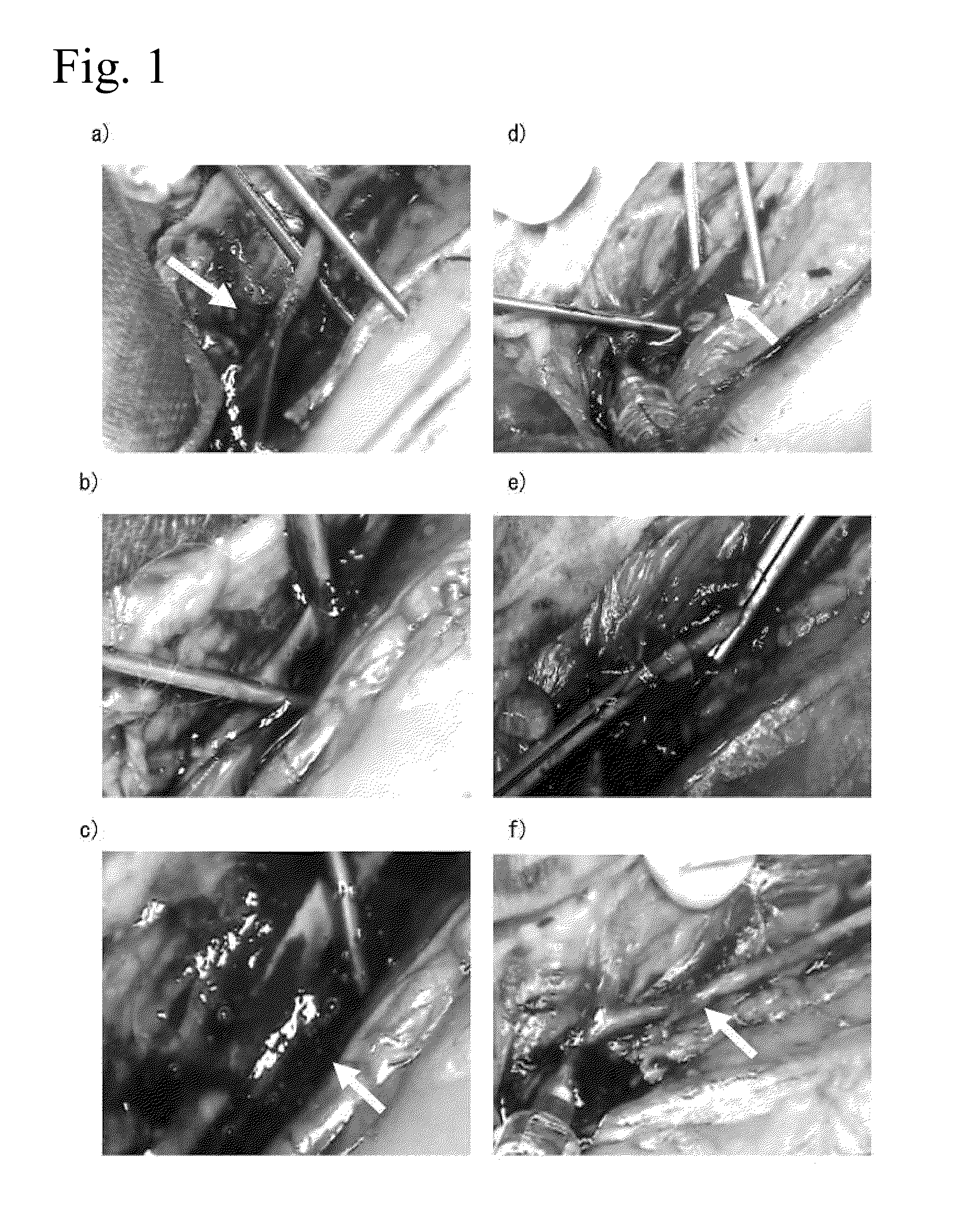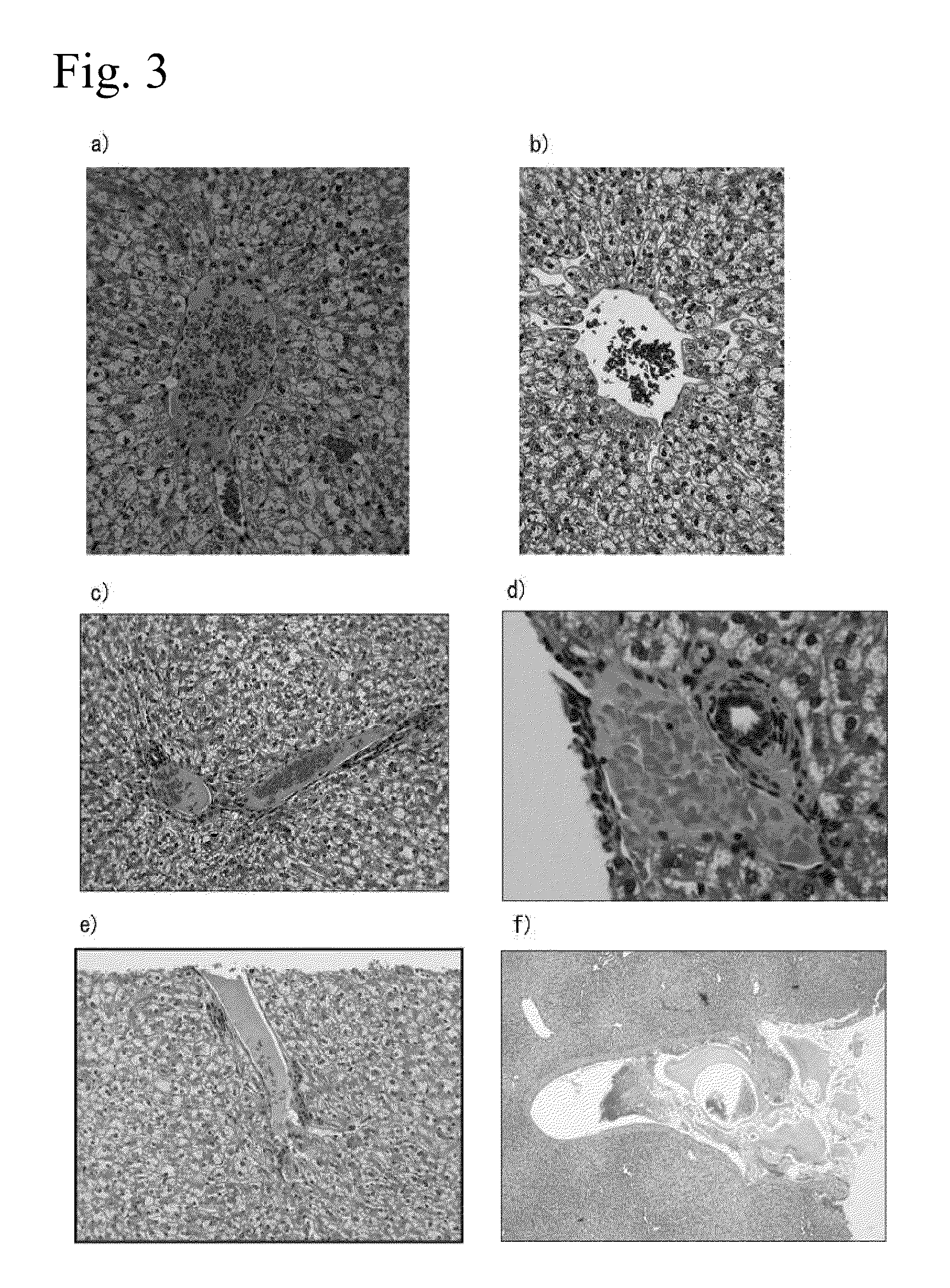Tissue occluding agent
a tissue occluding agent and tissue technology, applied in the direction of drug compositions, extracellular fluid disorders, peptide/protein ingredients, etc., can solve the problems of time and effort, high death probability, and inability to remove hemorrhaged blood, etc., to achieve adequate tissue occluding effect, improve tissue adhesion, and improve the effect of curative
- Summary
- Abstract
- Description
- Claims
- Application Information
AI Technical Summary
Benefits of technology
Problems solved by technology
Method used
Image
Examples
example 1
Hemostatic Effects of 1% Aqueous Peptide Solution and 3% Aqueous Peptide Solution in Rabbit Abdominal Aorta / Portal Vein Stem Injection Needle Perforation Model
[0094]A rabbit abdominal aorta and portal vein stem injection needle perforation model was prepared under vascular clamp, and the hemostatic effects of 1% aqueous peptide solution and 3% aqueous peptide solution were evaluated.
[0095]Aqueous Peptide Solutions
[0096]1.1% Aqueous peptide solution (peptide sequence: Ac-(RADA)4-NH2, CPC Scientific, Inc; concentration: wt / vol)
[0097]2.3% Aqueous peptide solution (peptide sequence: Ac-(RADA)4-NH2, CPC Scientific, Inc; concentration: wt / vol)
[0098]Animals
[0099]Japanese white rabbits (3.0-4.0 kg, Japan White, conventional, purchased from Funabashi Farm Co., Ltd.). The animals were bred with breeding pellets (JA Higashinihon Kumiai Shiryou) supplied in a breeding room controlled at a room temperature of 25° C., a humidity of 65% and an illumination time of 12 hours (7:00-19:00), and water ...
example 2
Hemostatic Effects of 1% Aqueous Peptide Solution and 3% Aqueous Peptide Solution in Rabbit Partial Liver Resection Model
[0105]A rabbit partial liver resection model was prepared and the hemostatic effects of 1% aqueous peptide solution and 3% aqueous peptide solution were evaluated.
[0106]Aqueous Peptide Solutions
[0107]1. 1% Aqueous peptide solution (peptide sequence: Ac-(RADA)4-NH2, CPC Scientific, Inc.)
[0108]2. 3% Aqueous peptide solution (peptide sequence: Ac-(RADA)4-NH2, CPC Scientific, Inc.)
[0109]Animals
[0110]Japanese white rabbits (3.0-4.0 kg, Japan White, conventional, purchased from Funabashi Farm Co., Ltd.). The animals were bred with breeding pellets (JA Higashinihon Kumiai Shiryou) supplied in a breeding room controlled to a room temperature of 25° C., a humidity of 65% and an illumination time of 12 hours (7:00-19:00), and water freely supplied with a water bottle. Fasting was from the morning of the test day, with water freely supplied.
[0111]The rabbits were subcutaneou...
example 3
Hemostatic Effect of Aqueous Peptide Solution in Abdominal Aorta Injection Needle Perforation Model of Rabbits with Suppressed Blood Clotting Function
[0117]The hemostatic effect of an aqueous peptide solution in rabbits administered an anticoagulant (heparin) was evaluated in an abdominal aorta injection needle perforation model.
[0118]Aqueous Peptide Solution
[0119]3% Aqueous peptide solution (peptide sequence: Ac-(RADA)4-NH2, CPC Scientific, Inc.)
[0120]Animals
[0121]Japanese white rabbits (3.0-4.0 kg, Japan White, conventional, purchased from Funabashi Farm Co., Ltd.). The animals were bred with breeding pellets (JA Higashinihon Kumiai Shiryou) supplied in a breeding room controlled to a room temperature of 25° C., a humidity of 65% and an illumination time of 12 hours (7:00-19:00), and water freely supplied with a water bottle. Fasting was from the morning of the test day, with water freely supplied.
[0122]The rabbits were subcutaneously administered (3 mg / kg) Celactar 2% injection (...
PUM
| Property | Measurement | Unit |
|---|---|---|
| Fraction | aaaaa | aaaaa |
| Fraction | aaaaa | aaaaa |
| Hydrophilicity | aaaaa | aaaaa |
Abstract
Description
Claims
Application Information
 Login to View More
Login to View More - R&D
- Intellectual Property
- Life Sciences
- Materials
- Tech Scout
- Unparalleled Data Quality
- Higher Quality Content
- 60% Fewer Hallucinations
Browse by: Latest US Patents, China's latest patents, Technical Efficacy Thesaurus, Application Domain, Technology Topic, Popular Technical Reports.
© 2025 PatSnap. All rights reserved.Legal|Privacy policy|Modern Slavery Act Transparency Statement|Sitemap|About US| Contact US: help@patsnap.com



